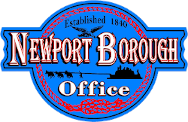Newport History
Newport is a small town located in Perry County, Pennsylvania nestled along the Juniata River. Settlers first arrived here in the 1760s. It was originally known as Ryder’s Ferry, the site of an early ferry on the Juniata River and was later named Newport after the canal was built. Grist mills became the first industry of the hamlet, thanks in part to river transportation to distant markets. The Pennsylvania Canal (1829) and the Pennsylvania Railroad (1849) accelerated economic development. From the Civil War into the 1920s, numerous industries produced iron, tannery products, bricks, textiles and lumber, and workers serviced canal boats, trains, and supported area agriculture. Newport was later established as a Borough in 1840.
Indians were the first inhabitants of this region, settling along the Big Buffalo and Little Buffalo creeks where game and fish were abundant. Tribes included the Delawares, Monseys, Shawnees and, most likely, the Tuscaroras. In 1754, the Indians sold a portion of this land to the English, and it became property of Thomas and John Penn. At this time, the first white settlers began moving in, and by 1758, the Indians were ordered by the English to leave. After patenting tracts in 1774 and 1775, David English was in possession of two plots of land: Grenada, the Newport tract; and Antigua, the plot immediately north. The land past through the English family to the Reider family.
In 1804, Paul, John, and Daniel Reider plotted the land into 54 lots with streets and alley. The foundation of the town extended from Mulberry Street to Oliver Street and from the Juniata River to Second Street. This promising town was known as Reider’s Ferry, later referred to as Reidersville.
The early economic growth of Newport was determined mainly from its location on the Juniata River. A ferry was established by the Reiders in the late 1700s. During the early era, freight was transported on rafts on the river. Rafts gave way to arks and keels, which were poled back up the river, and boat building became a significant business for the young community.
Ground was broken for the canal on July 4, 1826 in Harrisburg, and in 1829, the Juniata branch, which flowed through Newport, was opened, greatly increasing Newport’s position as a hub for water freight transportation. After the opening of the canal, the town officially became known as Newport. During this bustling time, Newport was home to warehouses, hotels, a photography gallery, a milliner, a tannery, and many other businesses. In fact, according to H. H. Hain, “Newport was the leading business town in Perry County, owing to its central location and shipping facilities.”
In 1840, Newport was incorporated as a borough with Sam Leiby being the first burgess and by 1846 the village had grown into a town of 100 homes. When the Pennsylvania Railroad completed rail service to the town in 1849, the foundation for the tremendous growth in the late 1800s was laid. During the early railroad era, Newport was a railroad hub.
Grain, lumber, leather and textiles produced in the surrounding communities were shipped via the trains passing through Newport. It was during this period that most of the major buildings were erected on the square to house the retail outlets and businesses necessary to support mill owners, workers, and the agricultural community. At the same time, lovely residences reflecting varied architectural styles were constructed.
The town is surrounded by magnificent natural beauty: lush valleys; farmland owned by families for generations; the spectacular Tuscarora mountain range; and the lovely meandering Juniata River.
Today, Newport is on the National Register of Historic Places, celebrating the domestic and business architecture of the 19th Century. The downtown square is a charming venue for eateries and specialty shops. The Borough of Newport is just 25 miles northwest of Harrisburg, Pennsylvania’s capital, and within close proximity to US Routes 22/322 a primary transportation corridor in the County. Quality schools, civic organizations, a public library, parks, and annual festivals contribute to a delightful small town and rural environment that continues to attract young families and retirees to a proud community now over 250 years old.
